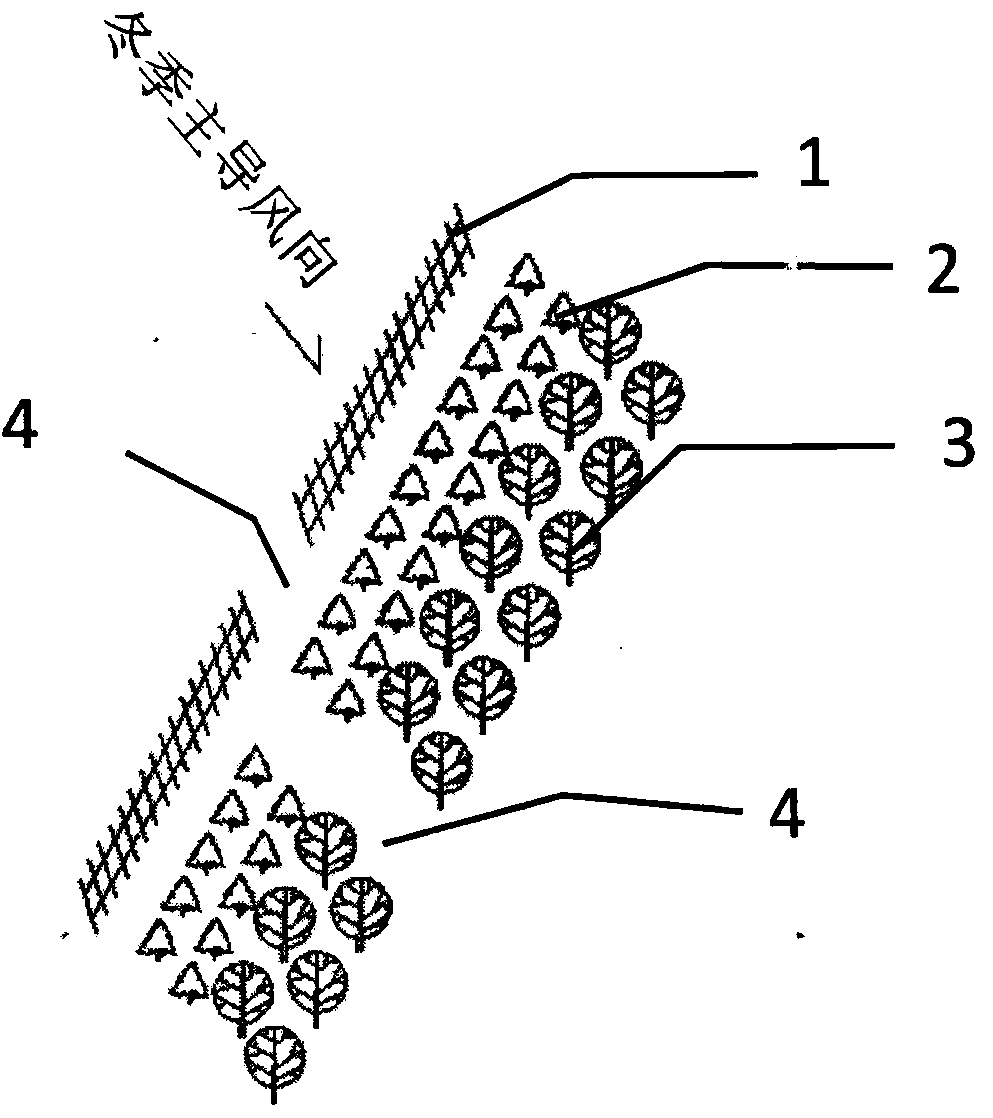Ecological utilization method of Mongolian plateau grassland snow-driving wind
A wind and snow, ecological technology, applied in the direction of soil preparation, application, climate change adaptation, etc., to achieve the effects of desertification prevention, high vegetation production capacity, and improvement of local microenvironment
- Summary
- Abstract
- Description
- Claims
- Application Information
AI Technical Summary
Problems solved by technology
Method used
Image
Examples
Embodiment 1
[0015] a. Choose a location with open and flat terrain;
[0016] b. Along the direction perpendicular to the local prevailing wind direction in winter, three mechanical wind barriers 1 with a height of 1.2m are arranged in parallel, and the ventilation structure is adopted, the ventilation coefficient is kept at 60%, and the width interval of each mechanical wind barrier 1 is 50m;
[0017] c. Plant 4 rows of native shrub seedlings on the leeward side of each mechanical wind barrier 1 at a position twice the height of the wind barrier, and establish a plant wind barrier 2. The spacing between seedlings and rows in the plant wind barrier 2 is 2m, and the seedlings between the rows are staggered in the shape of a character. Layout, the planting row close to the mechanical wind barrier 1 selects the shrub plant species with a smaller plant type as Caragana 5, and the planting row far away from the mechanical wind barrier 1 selects the taller shrub plant species as Caragana 3;
[0...
Embodiment 2
[0020] a. Choose a site with slightly low-lying terrain.
[0021] b. Arrange five mechanical wind barriers 1 in parallel along the direction that intersects with the local dominant wind direction in winter at a large angle > 60°. Mechanical wind barriers 1 can use various sand barriers for reference. The height is 1.5m, and the ventilation structure is adopted to maintain a ventilation coefficient of 70%. , each mechanical wind barrier 1 has a width spacing of 70m;
[0022] c. At 8 times the height of the wind barrier on the downwind side of each mechanical wind barrier 1, plant 6 rows of native shrub seedlings to establish a plant wind barrier 2. The spacing between the seedlings in the plant wind barrier 2 and the row spacing are 3m, and the seedlings between the rows are staggered in the shape of a character Layout, the planting row close to the mechanical wind barrier 1 selects the shrub plant species Caragana 2 with a relatively short plant type, and the planting row far ...
Embodiment 3
[0025] a. Choose a slightly low-lying area;
[0026] b. Along the direction perpendicular to the local prevailing wind direction in winter, 6 mechanical wind barriers 1 with a height of 1.8m are arranged in parallel, adopt a ventilation structure, the ventilation coefficient is kept at 80%, and the width of each mechanical wind barrier 1 is 100m apart;
[0027] c. At 10 times the height of the wind barrier on the downwind side of each mechanical wind barrier 1, plant 8 rows of native shrub seedlings, and establish a plant wind barrier 2. The plant and row spacing of the plant wind barrier 2 is 3m, and the seedlings between the rows are staggered in the shape of a character. Layout, the planting row close to the mechanical wind barrier 1 selects the shrub plant species Caragana 5 with a relatively short plant type, and the planting row far away from the mechanical wind barrier 1 selects the shrub species Haloxylon 3 with a relatively large plant type;
[0028] d. Make the mecha...
PUM
 Login to View More
Login to View More Abstract
Description
Claims
Application Information
 Login to View More
Login to View More - R&D
- Intellectual Property
- Life Sciences
- Materials
- Tech Scout
- Unparalleled Data Quality
- Higher Quality Content
- 60% Fewer Hallucinations
Browse by: Latest US Patents, China's latest patents, Technical Efficacy Thesaurus, Application Domain, Technology Topic, Popular Technical Reports.
© 2025 PatSnap. All rights reserved.Legal|Privacy policy|Modern Slavery Act Transparency Statement|Sitemap|About US| Contact US: help@patsnap.com

